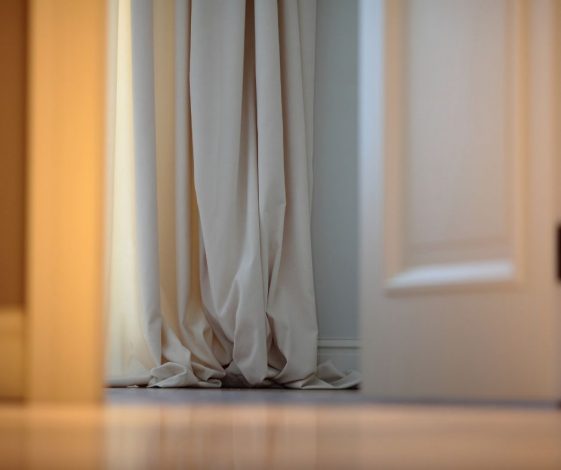Have you ever stood in front of a window, admiring the view, only to be distracted by curtains that seem to be floating just above the floor? It’s a common sight, but one that can make a room feel unfinished. The answer to the age-old question, “Are drapes supposed to touch the floor?”, is a resounding yes – but with a few key caveats. Drapery that grazes the floor adds an element of elegance and sophistication that no other window treatment can achieve. But achieving that perfect touch isn’t always a simple process.

Image: www.homeblisshq.com
Choosing the right length for your drapes goes beyond aesthetics; it can impact the overall feel of a room and even influence the way light filters in. From subtle nuances of style to practical considerations like preventing clutter and ensuring proper functionality, the length of your drapes matters. Let’s dive into the world of drapes and figure out how to achieve that perfect, floor-grazing elegance.
Why Drapes Should Touch the Floor
The Art of Elegance
Drapes that skim the floor exude an air of sophistication and refinement. This subtle detail instantly elevates the look of a room, creating a luxurious and polished ambiance. Imagine a beautifully furnished room with drapes that gracefully flow to the floor; it’s a visual cue that screams attention to detail, making a statement about your taste and style. The graceful lines of floor-length drapes create a sense of continuity and flow, visually connecting the window to the rest of the room.
Practical Benefits
Beyond beauty, there are practical benefits to drapes touching the floor. Floor-length drapes can help to insulate your home, reducing drafts and energy bills. Their length also prevents excess light from entering the room, creating a more intimate and comfortable atmosphere, especially important in bedrooms. Plus, they offer privacy, helping to block out unwanted views and creating a sense of seclusion.

Image: janniegrigsby.blogspot.com
Understanding Drapery Length
Let’s delve deeper into the world of drapery lengths. While “floor-length” generally refers to drapes that touch the floor, there are different interpretations of this length, each subtly changing the overall aesthetic.
The “Kissing the Floor” Drape
This style, as the name suggests, creates a graceful touch by simply brushing the floor. It’s a classic and elegant option that works well with most styles. The “kissing” effect adds a sense of lightness and movement.
The “Puddling” Drape
For a dramatic and luxurious look, opt for “puddling” drapes. These drapes deliberately pool on the floor, creating soft, flowing folds. This drape style adds a sense of grandeur and is often seen in formal settings or where a sense of drama is desired.
The “Break” Drape
This style is a bit more practical, ending about half an inch to an inch above the floor. This option is particularly useful in homes with pets or children, where a longer drape might be a tripping hazard. The “break” style still offers elegance while ensuring functionality.
Choosing the Right Drape Length for Your Home
Not all homes are created equal, and the ideal drape length will vary based on factors such as room size, window shape, and personal style. Here’s a guide to choosing the right length for your specific needs:
Room Size
In smaller rooms, longer drapes can make the space feel cramped. Consider a “break” style or a shorter curtain, allowing more light to enter and create a sense of spaciousness. On the other hand, larger rooms can handle the drama of “puddling” drapes.
Window Shape
Drape length should also be considered in relation to the window shape. For floor-to-ceiling windows, floor-length drapes are a natural choice. For shorter windows, you could use “break” drapes to maintain a balanced aesthetic.
Personal Style
Ultimately, the decision is yours. Consider your personal taste and the overall ambiance you want to create. For a modern space, consider a sleek, “break” style. For a traditional setting, a flowing “puddling” drape might be the perfect choice.
Expert Tips for Perfect Drapery
While the length of the drapes is important, it’s crucial to consider other details to achieve that flawless look.
Fabric Choice
The fabric you choose will impact the drape’s fall and appearance. Heavier fabrics are suitable for “puddling” styles, while lighter fabrics work well for “kissing” styles. Linen, silk, velvet, and cotton are some of the most popular choices for drapes, and each offers its own unique texture and feel.
Professional Installation
Remember, proper installation is crucial. A skilled professional can ensure the drapes hang perfectly and evenly. Consider investing in professional installation to avoid uneven hems or sagging issues.
Maintaining Your Drapes
Proper care will keep your drapes looking their best. Follow manufacturer instructions for cleaning and dusting. Regular washing and ironing will help prevent wrinkles and keep your drapes looking fresh.
Drape Length FAQs
Q: How do I measure my drapes?
Measure from the top of the rod to the desired length on the floor. Remember to account for the fullness of the fabric and any desired puddling.
Q: Can I hem my drapes myself?
Yes, but it requires a bit of precision. If you’re comfortable with sewing, consider a double-fold hem to create a clean and professional finish.
Q: Is it better to have drapes too long or too short?
A drape that is slightly too long is generally more forgiving than one that is too short. However, it’s always best to get the measurement right the first time.
Are Drapes Supposed To Touch The Floor
Conclusion
The perfect drape length should elevate your home’s décor and create a sense of luxury. Take your time to choose the right style and fabric for your room, and consider seeking professional installation for optimal results. A little attention to detail can transform your window treatments and create a beautiful and refined ambiance. Are you interested in learning more about different types of window treatments? We’d love to hear your thoughts!





